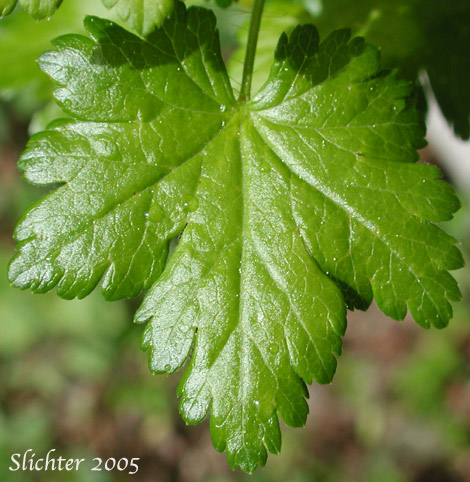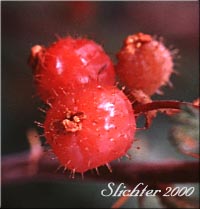 Characteristics:
Characteristics:
With its cleft, dark green leaves and small reddish-purple, saucer-shaped flowers, prickly currant can be an attractive shrub. However its stems are well armed with 3-5 parted spines at the nodes and many short, fine prickles between the nodes. It is definitely not a plant to blunder into! It is a shrub from 1-1.5 meters tall with spreading or ascending branches. The branches are smooth and reddish-brown. The leaves are simple but deeply 3-5 lobed, the lobes having blunt teeth along their edges. The blade is reminiscent of a maple leaf. Both leaf surfaces generally lack hairs, although some may be present. The upper surface as seen at right is often glossy. The leaves generally range from 3-8 cm across and are about as long as wide.
The inflorescence is a drooping, 7-20 flowered raceme, the main stem of the raceme sometimes with a zigzag appearance. The racemes arise from the leaf axils. Individual flowers are saucer-shaped and not hairy. The sepals are orbicular in shape and reddish-tinged. The 5 petals are pale yellowish-green to pinkish white and wider than long. The petals and stamens are both shorter than the sepals. The fruits are black and usually bristly-glandular in texture.
Prickly currant is a host for white pine blister rust. The plant is unpalatable, although the fruits are are used for jellies and jams.
 Photo
at left of the fruit of prickly currant from Strawberry Mt., Strawberry Mt. Wilderness
of central Oregon, September 4, 1999.
Photo
at left of the fruit of prickly currant from Strawberry Mt., Strawberry Mt. Wilderness
of central Oregon, September 4, 1999.
Prickly currant may be found in moist woods and stream banks, and also on drier woodland slopes or subalpine ridges.
Prickly currant can be found from Alaska south to California and east to Newfoundland, Michigan, Pennsylvania, South Dakota, Colorado, and Utah.
In the Columbia River Gorge, it can be found between the elevations of 100'-4500' from east of Cape Horn eastward to near the Little White Salmon River.